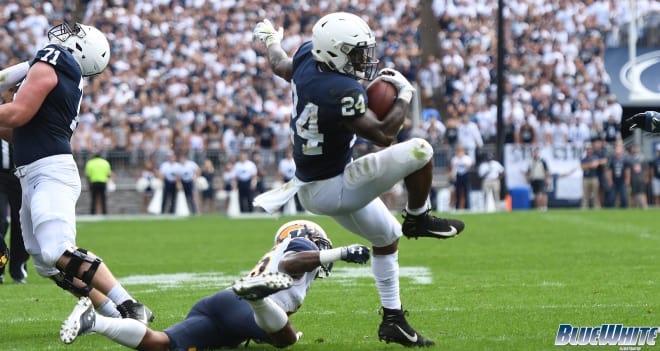Column: Making Them Miss
Saquon Barkley was doing again Sunday night what he’d done throughout his Penn State career.
His New York Giants, playing in Dallas for a Week Two nationally televised game, were losing to the Cowboys. Worse, in front of him and quarterback Eli Manning, the Giants’ offensive line was being beaten routinely by the Cowboys’ front seven leaving Manning scrambling for survival and Barkley to fend for himself.
Which, of course, Barkley has repeatedly proven himself more than capable at doing.
Spinning, leaping, juking past, and running through the Cowboys defense, Barkley somehow managed to make a highlight reel of a night that might be considered otherwise pedestrian statistically. Finishing with 11 carries for 28 yards, the longest of which went for 10 yards, Barkley made most of his impact for the Giants in the passing game, reeling in 14 receptions for 80 yards.
So entertaining was Barkley, in fact, his performance warranted repeated marveling from NBC color commentator Chris Collinsworth.
“He’s not a quarterback, but it sure is fun to watch him play, isn’t it?” said Collinsworth. “It seems like every first opportunity to tackle him has been missed so far in this game.”
Back in State College, something very similar can be said of Barkley’s former running mate.
Sitting at the podium of the Beaver Stadium media room surrounded by reporters late Saturday afternoon, Nittany Lions’ junior running back Miles Sanders had just tallied another 86 yards rushing on 14 carries against Kent State. The performance boosted his season totals to 295 yards rushing on 49 carries, including two touchdowns, as his team improved to 3-0 on the season with a 63-10 win against the Golden Flashes.
The manner in which Sanders piled up the yards was what most stood out, though.
The former Rivals.com No. 1 all-purpose back in the Class of 2016, the one who’d arrived at Penn State at 5-foot-11, 200 pounds, was running through, past, and over his defensive opponents. Not unlike Barkley, Sanders was effectively proving himself as a more-than-capable between-the-tackles stud.
Taking note of his penchant for pushing past the first tackler, Sanders acknowledged the increasingly important element of his game.
“It’s just having that mindset of just not being tackled by the first defender,” he said. “It creates more yards and creates better opportunities for our offense. I’m just trying to get as many yards as I can every time I touch the ball.”

Sanders, having admittedly tired of the frequent comparisons to and questions about Barkley leading into the 2018 season, credited Barkley for the mentality.
During a career that spanned through struggles to the eventual stability of Penn State’s offensive line, Barkley routinely had to make defenders miss in his own backfield or break through an initial touch in order to produce positive yards. Absorbing that influence, Sanders approached the possibility with the same resolution.
“Just watching Saquon, that’s what he does best is breaking tackles,” said Sanders. “Watching him now in the league, some people can’t make the runs that he makes. Being that tough running back is just breaking tackles and getting as many yards as I can.”
Actually, Sanders could prove himself to be just as good at that particular element of his game.
According to the advanced statistics compiled by Pro Football Focus, through the first three weeks of the 2018 season, Sanders led the nation in yards after contact per attempt. For tailbacks with a minimum of at least 40 carries to that point in the year, Sanders’ average of 4.58 yards after contact per attempt represented the best number among all Football Bowl Subdivision tailbacks, ahead of Wisconsin’s Jonathan Taylor (3.94), Ohio State’s J.K. Dobbins (3.11), and Pitt’s Qadree Ollison (2.84), among others in the category.
It was also better than Barkley’s 3.45 average through the 2017 season, 3.28 in 2016, or 3.82 mark in 2015.
Constantly falling forward to pick up extra yards, even as he’s being tackled, Sanders’ running style is one in which he consistently picks up yards beyond his first obstacle, contact or not. In fact, in what is likely as much a commentary on the improved play for Penn State’s offensive line through the nonconference portion of the schedule, Sanders also has rarely ever found himself being dropped behind the line of scrimmage. On his 49 carries, only eight have gone for just 20 yards in losses.
Given how much Sanders’ teammates up front are working for his success, the positive momentum is something they collectively are looking forward to continuing upon entering the Big Ten slate.
“Miles has done an unbelievable job this year,” said junior left tackle Ryan Bates. “We expect a lot from him. I say “we,” I mean the offensive line. We work out butts off up front just for that dude back there. All the running backs, not just him, (but) we have high expectations for him. He sat behind Saquon for a year or so and all you heard about was Saquon, but he is his own back and his own person. He is going to play how Miles plays.”
Now a leader of Penn State’s running back room himself, “how Miles plays” is equally influential on the rest of a group working to emulate his example. Whether it’s true freshman Ricky Slade, senior Johnathan Thomas, redshirt freshman Journey Brown, or fifth-year senior Mark Allen, the whole collection of Nittany Lion running backs share Sanders’ determination to elude the first defender by any means necessary.
So much so, in fact, that Sanders isn’t the only one smiling over it.
Even before the start of the season, new Penn State offensive coordinator Ricky Rahne understood his feature tailback to be fully capable of filling that role, one broken tackle and missed man at a time.
“Miles is a big guy with great speed,” said Rahne. “He's got almost the same size that Saquon has. He's gotten a lot bigger, a lot more physical. He has very, very good vision, especially in between the tackles. But he has the speed to play on the perimeter and make plays out there. His ability to break tackles and have great balance on contact and things like that is going to be a huge asset.”
So far, it has been.
